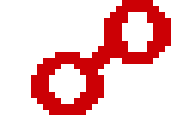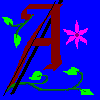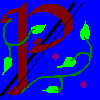(See also here for
advanced information on aspects and harmonics.)
The aspects denote astronomically the number of degrees one planet is
from another, astrologically how the planets relate to each other.
Some numbers are more important than others, and some are so important
that an astrologer gives them a little leeway; in other words the
planets need not be exactly in the specified distance, but have
an orb of between 2 and 8 degrees.
The aspects may be neutral, harmonious or challenging and thus
determine the nature of the relationships between the planets.
However, harmonious is something you get served with a silver spoon -
it may make you greedy. On the other hand a challenging aspect gives the
opportunity to learn.
The most common are the following:
 Conjunction: 0o, with an orb of 8, this is a neutral
and major aspect, where the planets meld together for better or
worse.
Conjunction: 0o, with an orb of 8, this is a neutral
and major aspect, where the planets meld together for better or
worse.
A sun/Venus conjunction makes the person pleasuresick but artistic
A Mars/North Node conjunction means the person needs to learn
assertiveness and the use of will
A Moon/Pluto conjunction is emotional blackmailing, but also ruthless
honesty with own emotions.
And of course, all are modified by house and sign. The first
configuration in Aries in the 5. house is active, flirting and
romantic, or may be a daring artist with bold tunes and colours, but in
Aquarius in the 8. would be something of an experimenting and sensual
lover.
 Semi-sextile:
30o, with an orb of maximum 2, this is
a minor and weakly positive aspect. One planet will be one sign ahead
of the other, and will manifest something the other needs (and
hopefully wishes) to learn.
Semi-sextile:
30o, with an orb of maximum 2, this is
a minor and weakly positive aspect. One planet will be one sign ahead
of the other, and will manifest something the other needs (and
hopefully wishes) to learn.
Moon in Gemini semisextile Saturn in Taurus, may mean that a very
practical oriented Saturn needs to learn to speak of his needs and
wishes, and there is a possibility that the Moon will do this for
him.
 Semi-square: 45o, with an orb of maximum 2 degrees,
this is a weak, challenging aspect. The planets have little in common,
and represent different stages of life. Otherwise, interpret as a weak
square.
Semi-square: 45o, with an orb of maximum 2 degrees,
this is a weak, challenging aspect. The planets have little in common,
and represent different stages of life. Otherwise, interpret as a weak
square.
Septile: 51o, with an orb of 2 or 3 degrees, this
aspect gives creative inspiration, and has a distinctly neptunian
flavour according to one Dr.
Maggie McPherson
 Sextile: 60o, with an orb of 4 degrees, this aspect
is of medium positive quality. The planets are friendly towards each
other.
Sextile: 60o, with an orb of 4 degrees, this aspect
is of medium positive quality. The planets are friendly towards each
other.
Example:
Neptune sextile Ascendant gives a mild, dreamy demeanour. The person seems
gentle, and probably has an active dreamlife.
 Quintile: 72o, with an orb of 2 or 3 degrees seems to
have a Mercurial quality, and link mind to matter in _expressed_
creativity.
Quintile: 72o, with an orb of 2 or 3 degrees seems to
have a Mercurial quality, and link mind to matter in _expressed_
creativity.
 Square: 90o, with an orb of 8 degrees, this is a major
negative aspect. The planets go in different directions and there is no
compromise. The person must always choose which to emphasise, and for best
results, be mindful of both. She cannot please both energies at the same
time. The planets will be of the same quality (usually); i.e. both in
Mutable signs for instance, but of different elements.
Square: 90o, with an orb of 8 degrees, this is a major
negative aspect. The planets go in different directions and there is no
compromise. The person must always choose which to emphasise, and for best
results, be mindful of both. She cannot please both energies at the same
time. The planets will be of the same quality (usually); i.e. both in
Mutable signs for instance, but of different elements.
Example: Saturn in 9. square Cheiron in 6. indicates that she must
choose between patience and dedication in higher education, and social
service.
Mercury in Aries square Node-axis in Cancer (North)/Capricorn (South)
indicates that his tendency to speak rashly and without thinking is
contrary to his learning of emotions and acceptance of such. It also
conflicts with his instinct to pull rank when things go wrong.
Biseptile: 103o, is similar to the septile.
 Trine: 120o, of orb 8 degrees, is the major positive
aspect. The planets are in the same element, and work in harmony with each
other.
Trine: 120o, of orb 8 degrees, is the major positive
aspect. The planets are in the same element, and work in harmony with each
other.
Examples: Mars in Sagittarius trine MC in Leo indicates that the
happy-go-lucky, jovial energy is beneficial to his career, perhaps in
drama. He shows himself royal, and his energy warms that impression and
gives him a purpose.
Uranus in the 3. trine Moon in the 7. indicates that the person has
changeable emotions, or, bright at school, she may find her partner there.
Or a highly emotional partner is beneficial to her mind and flair for
writing. He may even inspire her to greater heights.
 Sesquiquadrate: 135o, is similar to the semisquare.
Sesquiquadrate: 135o, is similar to the semisquare.
Biquintile: 144o, is similar to the quintile.
 Quincunx or inconjunct: 150o, a confusing minor aspect
of about 3 to 4 degrees orb. The relationship between the planets is a bit
iffy; sometimes good, sometimes not. Because of the orbs, it can behave
both like the biquintile and the triseptile. The planets are 5 signs
apart; they have nothing in common, they don't even follow each other like
the semisextile. However one may be of service to the other, and the
other may be a mystery to the first, like the Aries/Virgo and
Aries/Scorpio relationships.
Quincunx or inconjunct: 150o, a confusing minor aspect
of about 3 to 4 degrees orb. The relationship between the planets is a bit
iffy; sometimes good, sometimes not. Because of the orbs, it can behave
both like the biquintile and the triseptile. The planets are 5 signs
apart; they have nothing in common, they don't even follow each other like
the semisextile. However one may be of service to the other, and the
other may be a mystery to the first, like the Aries/Virgo and
Aries/Scorpio relationships.
Examples:
Venus in Libra inconjunct the Moon in Pisces indicates that the charming,
aesthetic Venus may bring to life the mysterious, changing emotions of the
Moon, but that the person my also loose herself somewhat in dreams and
fancies e.g. of Prince Charming.
Triseptile: 154o, is similar to the septile.
 Opposition: 180o, of orb 8 degrees is a major
challenging aspect, where the planets draw in opposite directions, and
bring out the bad sides in each other.
Opposition: 180o, of orb 8 degrees is a major
challenging aspect, where the planets draw in opposite directions, and
bring out the bad sides in each other.
Examples:
Pluto 12. opposite Mercury in Pisces, 6. indicates that the poetic,
serving aspect is not compatible with the volatile unconscious. The person
may try to control others through evasiveness or appealing to their
subconscious (malevolent use of symbolism, brainwashing, etc), or be so
bent on speaking the minds of their clients, that they destroy
themselves.
 spects between
spects between  lanets
lanets



 Conjunction: 0o, with an orb of 8, this is a neutral
and major aspect, where the planets meld together for better or
worse.
Conjunction: 0o, with an orb of 8, this is a neutral
and major aspect, where the planets meld together for better or
worse. Semi-sextile:
30o, with an orb of maximum 2, this is
a minor and weakly positive aspect. One planet will be one sign ahead
of the other, and will manifest something the other needs (and
hopefully wishes) to learn.
Semi-sextile:
30o, with an orb of maximum 2, this is
a minor and weakly positive aspect. One planet will be one sign ahead
of the other, and will manifest something the other needs (and
hopefully wishes) to learn. Semi-square: 45o, with an orb of maximum 2 degrees,
this is a weak, challenging aspect. The planets have little in common,
and represent different stages of life. Otherwise, interpret as a weak
square.
Semi-square: 45o, with an orb of maximum 2 degrees,
this is a weak, challenging aspect. The planets have little in common,
and represent different stages of life. Otherwise, interpret as a weak
square. Sextile: 60o, with an orb of 4 degrees, this aspect
is of medium positive quality. The planets are friendly towards each
other.
Sextile: 60o, with an orb of 4 degrees, this aspect
is of medium positive quality. The planets are friendly towards each
other. Quintile: 72o, with an orb of 2 or 3 degrees seems to
have a Mercurial quality, and link mind to matter in _expressed_
creativity.
Quintile: 72o, with an orb of 2 or 3 degrees seems to
have a Mercurial quality, and link mind to matter in _expressed_
creativity. Square: 90o, with an orb of 8 degrees, this is a major
negative aspect. The planets go in different directions and there is no
compromise. The person must always choose which to emphasise, and for best
results, be mindful of both. She cannot please both energies at the same
time. The planets will be of the same quality (usually); i.e. both in
Mutable signs for instance, but of different elements.
Square: 90o, with an orb of 8 degrees, this is a major
negative aspect. The planets go in different directions and there is no
compromise. The person must always choose which to emphasise, and for best
results, be mindful of both. She cannot please both energies at the same
time. The planets will be of the same quality (usually); i.e. both in
Mutable signs for instance, but of different elements. Trine: 120o, of orb 8 degrees, is the major positive
aspect. The planets are in the same element, and work in harmony with each
other.
Trine: 120o, of orb 8 degrees, is the major positive
aspect. The planets are in the same element, and work in harmony with each
other. Sesquiquadrate: 135o, is similar to the semisquare.
Sesquiquadrate: 135o, is similar to the semisquare. Quincunx or inconjunct: 150o, a confusing minor aspect
of about 3 to 4 degrees orb. The relationship between the planets is a bit
iffy; sometimes good, sometimes not. Because of the orbs, it can behave
both like the biquintile and the triseptile. The planets are 5 signs
apart; they have nothing in common, they don't even follow each other like
the semisextile. However one may be of service to the other, and the
other may be a mystery to the first, like the Aries/Virgo and
Aries/Scorpio relationships.
Quincunx or inconjunct: 150o, a confusing minor aspect
of about 3 to 4 degrees orb. The relationship between the planets is a bit
iffy; sometimes good, sometimes not. Because of the orbs, it can behave
both like the biquintile and the triseptile. The planets are 5 signs
apart; they have nothing in common, they don't even follow each other like
the semisextile. However one may be of service to the other, and the
other may be a mystery to the first, like the Aries/Virgo and
Aries/Scorpio relationships. Opposition: 180o, of orb 8 degrees is a major
challenging aspect, where the planets draw in opposite directions, and
bring out the bad sides in each other.
Opposition: 180o, of orb 8 degrees is a major
challenging aspect, where the planets draw in opposite directions, and
bring out the bad sides in each other.